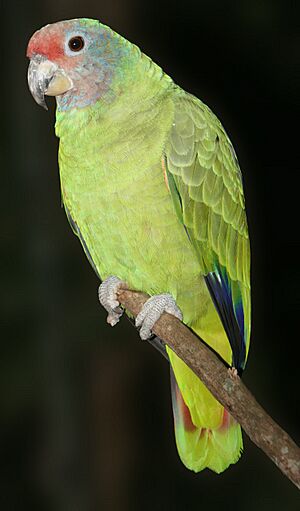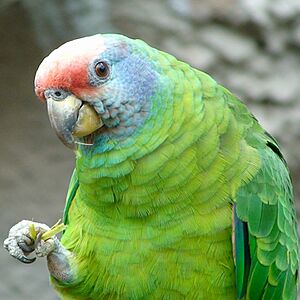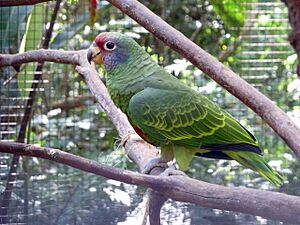Red-tailed amazon facts for kids
Quick facts for kids Red-tailed amazon |
|
|---|---|
 |
|
| Conservation status | |
| Scientific classification | |
| Genus: |
Amazona
|
| Species: |
brasiliensis
|
 |
|
| Synonyms | |
|
Psittacus brasiliensis Linnaeus, 1758 |
|
The red-tailed amazon (Amazona brasiliensis), also known as the red-tailed parrot, is a beautiful parrot. It lives only along the coast of Brazil. You can find these colorful birds in the states of São Paulo and Paraná.
Sadly, their natural homes are shrinking. Also, some people illegally catch them to sell. Because of these threats, the red-tailed amazon is considered "Near Threatened" by groups like BirdLife International. This means it could become endangered if we don't protect it. The good news is that conservation efforts are helping. Their numbers are slowly growing, showing that these parrots are recovering.
Contents
About the Red-tailed Amazon
What do they look like?
Red-tailed amazons weigh about 425 grams (15 ounces). They are around 35 centimeters (14 inches) long. As their name suggests, they have a wide red band on their tail. This red part is mostly seen when the tail is spread open. Their tail also has a bright yellow tip. The outer tail feathers are dark blue at the bottom.
Most of their body feathers are green. Their throat, cheeks, and ear areas are purple-blue. The top of their head is red. They have a yellowish beak with a black tip. Their eyes have a pale gray ring around them, and their irises (the colored part of the eye) are orange. Young parrots have duller colors and brown irises.
Where do they live?
The red-tailed amazon lives in the Atlantic Forest system. They prefer forests, woodlands, and mangroves close to the coast. These parrots usually live in low areas, below 200 meters (650 feet) above sea level. Sometimes, they can be found higher, up to 700 meters (2,300 feet).
How do they behave?
Red-tailed amazons are often seen in pairs or small groups. Sometimes, outside of breeding season, hundreds of them can gather together. They usually sleep and raise their young on coastal islands. However, they fly to the nearby mainland to find food. Their diet mainly includes fruits. They also eat seeds, flowers, nectar, and sometimes even insects.
Reproduction and Life Cycle
Red-tailed amazons breed in mangrove and coastal forests on islands. Their breeding season is from September to February. During this time, the female parrot lays three or four eggs in natural tree holes. The eggs hatch after about 27 to 28 days. The young parrots stay in the nest for another 50 to 55 days before they are ready to fly.
Why are they in danger?
Loss of their home
One big reason red-tailed amazons are in danger is the loss of their home. Brazil's growth has led to a lot of logging. Huge areas of forest are cut down. This destroys the places where thousands of plants and animals live. This logging takes away the parrots' homes and their food sources. When their homes are destroyed, the birds have to move to less suitable areas. Often, they cannot find enough food and may not survive.
The Atlantic coastal forest, which is the main home for these birds, has been greatly reduced. Only a small part of the original forest remains. This remaining land is often broken up by roads and buildings. This makes it hard for large groups of parrots to find enough food in one place. This breaking up of their habitat also makes their nests easier targets for predators, both human and animal.
Illegal animal trade
Illegal animal trade also threatens the red-tailed amazon. These parrots are easy targets for people who illegally catch and sell animals. This is because of their bright colors and where they breed. Studies have shown that many nests are raided by humans.
People who illegally catch these birds often damage the fragile nests. This means the parrots cannot use those nests again. They are forced to build new nests elsewhere. Once caught, the birds are often smuggled in small containers. Many parrots die during this journey from thirst, hunger, or injuries. Sadly, a very high number of parrots do not survive the trip. This illegal trade harms the parrot population and their ecosystem.
How are they being protected?
Education and help
Many steps are being taken to help these parrots. One program, started in 1997, teaches local people about the importance of these birds. It aims to reduce threats through educational activities. This program works with students, women, and artists. They host workshops and field trips to raise awareness about the red-tailed amazon. They hope this will help reduce logging and illegal animal trade.
Zoos are also helping to protect the birds. Red-tailed amazons can breed well in zoos. There are successful breeding programs in Europe and Brazil. Zoos like Chester Zoo have successfully bred these parrots.
A very important step was creating Superagui National Park in 1989. This park protects over 34,254 hectares (84,640 acres) of lush forest. It is part of the largest continuous Atlantic rainforest. This park provides a safe home for the red-tailed amazon and many other species.
Laws and rules
Laws are also in place to stop the illegal trade of these parrots. The United States Endangered Species Act (ESA) helps protect them from being illegally brought into the U.S. If a bird is imported illegally, it will be taken, and the person will be punished. The United States Fish and Wildlife Service checks luggage at airports to prevent illegal animal trade.
The Convention on International Trade in Endangered Species of Wild Fauna and Flora (CITES) also protects the species. It lists the red-tailed amazon under Appendix I. This is the highest level of protection against international trade. These laws help control the trade of parrots, but sometimes they are not fully enforced.
Why are they important?
Red-tailed amazons play a very important role in spreading seeds. As they fly between the mainland and coastal islands, they drop seeds through their waste. This helps new plants grow and keeps the forests healthy and diverse.
These birds also help people earn money. Tourists come to see the parrots in their natural habitat. Some people come to watch their migration, while others simply enjoy seeing them in their home. This tourism helps local communities.





